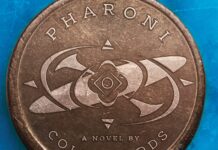1.
Is it possible that the idea of “realism” as a guiding principle for fiction is itself unrealistic? After all, there are no Newtonian laws in stories—an apple can just as easily fly upward from a tree as drop to the ground. Characters can ride a magic carpet as easily as walk. Any restrictions are imposed by the author, not by any external “reality,” however defined.
The first storytellers understood this intuitively. That is why myths, legends, folk tales and other traditional stories recognize no Newtonian (or other) limitations on their narrative accounts. These were the first examples of what I call “conceptual fiction”— in other words stories that delight in the freedom from “reality” that storytelling allows. Conceptual fiction plays with our conception of reality, rather than defers to it.
In the past, conceptual fiction existed at the center of our literary (and even pre-literary) culture. Nowadays it is dismissed by critics and typically shuffled off into “genre” categories such as science fiction and fantasy. Realism gained preeminence as a supposedly rock hard foundation for fiction. From that moment on, Newton’s laws (and a million other laws) gave orders to the imagination, with the stamp of approval of the literary establishment.
But here is the more interesting question. Is it possible that this trend is reversing, and that conceptual fiction is now moving back from the periphery into the center of our literary culture?
2.
How important is realism in storytelling today? If one judges by the comments (and, even more importantly, the unstated assumptions) of critics as diverse as James Wood and Michiko Kakutani, then realism is the foundation of our literary culture, and storytellers ignore it at their own peril.
But take a look at the most formative and influential stories of our age, namely the best-known motion pictures. (We will return to the novel in a second.) Of the 50 top grossing films of all time, only 7 reveal even the slightest tendency toward realism. (And I need to categorize Forrest Gump, The Titanic, Raider of the Lost Ark, and Jaws as realistic to even get to seven). You can denounce Hollywood as much as you like, and ridicule the uneducated tastes of moviegoers. Yet we see what they think of realism every time we go the local multiplex.
But I can sense your scorn of Hollywood even from where I am sitting across the great world wide web. And I am confident that you have never debased yourself to the point of seeing and enjoying any of these megahits. So let’s turn to the novel. Is it possible that even the novel—the serious novel–is now falling out of the gravitational pull of realism? (Ah, I love that adjective: whenever I hear “serious” used by a literary critic, I am reminded of John McEnroe taunting the umpire at Wimbledon in his whiny voice: “You can NOT be SERIOUS.“)
Let’s look more deeply into this matter.
3.
During the middle decades of the 20th century, literary works that experimented with language were seen as harbingers of the future. These Joycean and Poundian and Faulknerian creations were singled out for praise and held as models for emulation. These works won awards, were taught in universities, and gained acceptance (at least in highbrow circles) as contemporary classics.
During these same years, another group of writers, universally scorned by academics and critics, were working on different ways of conceptualizing reality. Unlike the highbrow writers, they did not experiment with sentences, but rather with the possible worlds that these sentences described. These authors often worked in so-called “genre styles” of fiction (science fiction, fantasy), publishing in pulp fiction periodicals and heap paperbacks. Despite the futuristic tenor of their writing, these authors were not seen as portents of the future. And though these books sold in huge quantities and developed a zealous following among readers, these signs of commercial success only served to increase the suspicion and scorn with which these books were dealt with in highbrow circles.
4.
In a strange quirk of history, literature in the late 20th and early 21st century failed to follow in the footsteps of Joyce and Pound. Instead, conceptual fiction came to the fore, and a wide range of writers—highbrow and lowbrow—focused on literary metaphysics, a scenario in which sentences stayed the same as they always were, but the “reality” they described was subject to modification, distortion and enhancement.
This was seen in the magical realism of Gabriel Garcia Marquez and Salman Rushdie; the alternative histories of Michael Chabon and Philip Roth; the modernist allegories of José Saramago; the political dystopias of Margaret Atwood and Kazuo Ishiguro; the quasi-sci-fi scenarios of Jonathan Lethem and David Foster Wallace; the reality-stretching narratives of David Mitchell and Audrey Niffenegger; the urban mysticism of Haruki Murakami and Mark Z. Danielewski; the meta-reality musings of Paul Auster and Italo Calvino; the edgy futurism of J.G. Ballard and Iain Banks; and the works of hosts of other writers.
5.
Of course, very few critics or academics linked these works to their pulp fiction predecessors. Cormac McCarthy might win a Pulitzer Prize for his novel The Road, a book whose apocalyptic theme was straight out of the science fiction playbook. But no bookstore would dare to put this novel in the sci-fi section. No respectable critic would dare compare it to, say, I Am Legend (a novel very similar to McCarthy’s in many respects). Arbitrary divisions between “serious fiction” and “genre fiction” were enforced, even when no legitimate dividing line existed.
Only commercial considerations dictated the separation. Literary critics, who should have been the first to sniff out the phoniness of this state of affairs, seemed blissfully ignorant that anything was amiss.
José Saramago’s Blindness might have a plot that follows in the footsteps of Michael Crichton’s The Andromeda Strain or Greg Bear’s Blood Music, but no academic would ever mention these books in the same breath. Toni Morrison’s Beloved might have as its title character a ghost and build its action around a haunting, but no one would dare compare it to a horror novel—even though it has all of the key ingredients.
It almost seemed as if the book industry (and critics and academics) had reached a tacit agreement. “If you don’t tell people that these works follow in the footsteps of genre fiction books, we won’t either.” Yet this was merely a commercial decision. After all, what serious reader would buy these books if they had the taint of sci-fi or fantasy? When would any Pulitzer or Nobel panel give an award to a book that was explicitly linked to genre fiction? They wouldn’t. So a charade needed to be played, in which some works of conceptual fiction were allowed to sit on the same shelf as the serious books (ah, that McEnroe voice again), while others were ghetto-ized in a different location, whether it be in a library or a bookstore or something more intangible like your mind.
6.
This state of affairs pointed to the fundamental flaw in viewing works of science fiction and fantasy as similar to other genre books.
Other genre categories—mysteries, romances, etc.—have very strict limitations on their plots, characters, narrative structures, etc. A mystery book must have a crime and a solution to the crime. A romance book must have a love story that proceeds along more or less familiar lines. These formulas must be followed at all costs.
But the science fiction and fantasy categories were far more freeform. Almost anything could happen in these books, provided they played some game with our concept of reality. The only promises these works made were to astound and delight us. This was not a formula—indeed it was the exact opposite of a formula.
Just look at the names of the early sci-fi magazines: they were called Amazing or Astounding or or Fantastic or tagged with some equally ambitious title. . . (my favorite: Weird Tales). Ah, what could be grander than magazines that forged such extravagant covenants with their readers? Not even The New Yorker promises that every issue will be astounding.
In essence, sci-fi and fantasy never fit nicely into the genre pigeonhole. And given their focus on surprising and delighting readers—rather than following strict formulas of plot development and resolution—it was inevitable that “serious writers” would begin borrowing from these scorned writers who existed at the fringes of the literary world.
7.
Critics and academics and even readers have largely missed the implications of this. They prefer to live in denial. A critic as astute as James Wood—who ranks, for better or worse, among the most influential writers on literature of our time—can continue to pretend that the “realist” tradition in fiction somehow reigns supreme. Yet any perspicacious reader should be able to see that tinkering with reality is the real driving force in contemporary fiction, and has been for a long time.
8.
Anthropologist Clifford Geertz differentiated between “thin” and “thick” ways of describing cultures—labels that have since been borrowed by other disciplines. The “thin” approach focuses on a specific aspect of a social situation, whereas the “thick”
perspective also tries to capture the context as well.
Fiction can also adopt “thick” or “thin” perspectives. And it should come as little surprise that many of the most notable examples of “thick” storytelling reside in the world of conceptual fiction. J.R.R. Tolkien’s Middle-earth, Frank Herbert’s Dune, C.S. Lewis’s Narnia, J.K. Rowling’s Hogwarts, Gabriel Garcia Marquez’s magical-realist landscapes . . . these all stand out as marvelously thick, ethnographies of the imagination. And why the connection between thick descriptions and fantasy / magical / sci-fi stories? Because these genres cannot take context for granted, as do so many so-called “serious” novels. The meticulous creation of a vivid and inspired context is usually essential to the overall effect in any extended work of conceptual
fiction.
In contrast, when a literary writer attempts a thick description in the context of a traditional narrative—for example, in writing a novel set during the time of the French Revolution or the Civil War—the many telling details that establish the context are typically drawn from research rather than from the grand leaps of the imagination that created Middle-earth or Rowling’s magically-charged variant on contemporary Britain. And when a literary novel is set in the current day, the approach taken by the writer is, more often than not, a thin one, since the context is largely familiar to all readers. The writer working in conceptual fiction genres has no such support. One might even decide to rename conceptual fiction as “contextual fiction,” since so much of the power of these works depend on the author’s ability to create a powerful context within which the story is situated.
We should not make light of the difficulty—or, indeed, the artistry—involved in creating a successful work of “thick” fiction out of pure imagination. Yet how many literary critics will deign even to notice a book such as Frank Herbert’s Dune, let alone praise it? The invisibility of this “thick account” masterpiece in literary discussions is hardly a sign of any failing on the part of Herbert. Rather it reveals that the literary world, for all its espousal of open-minded, egalitarian attitudes, has its own unexamined areas of snobbery and intolerance.
Of course, readers pay little attention to these things. The “thick” works of conceptual fiction mentioned above by Tolkien, Lewis, Rowling and Herbert are among the most widely read books of the last century. According to many in the literary establishment, this must simply be a sign of the stupidity of the masses. And they must be especially stupid to read thousands of pages (since these are usually long books or parts of series) of such poorly written books.
Then again, this glib dismissal from highbrow critics might itself be suspect and worthy of scrutiny.
9.
The term “science fiction” as it is applied to many of these works is especially unfortunate, since the inclusion of science is not the decisive factor in setting these books apart. Otherwise a book such as Richard Powers’ The Gold Bug Variations—which rhapsodizes about science on almost every page—would be a work of conceptual fiction. It is not. At no point is the reader’s sense of reality challenged by the straightforward narrative style of Powers’ novel, which is a fine book indeed, but with little in common with the stories discussed here.
By the same token, it is easy to see how mistaken those fans are who proclaim the superiority of so-called “hard” science fiction— in other words stories with a large dose of “real” science in them.
Even a quick survey of science fiction books shows that the science is almost always bogus, and simply serves as a gateway for bringing imaginative elements into the narrative. The greatness of these books does not derive from their chemistry or physics or genetic engineering (which almost always prove to laughably wrong-headed a few years after the book is published, if not sooner), but in the writer’s visionary reconfiguration of our conceptions of the real.
10.
Given this situation, we need to return to the many masterworks of conceptual fiction from earlier decades, and reassess their importance. Authors such as Philip K. Dick, Robert Heinlein, Isaac Asimov, Ursula K. Le Guin, J. R. R. Tolkien, Arthur C. Clarke, Ray Bradbury, C.S. Lewis, Frank Herbert, Robert Silverberg, Alfred Bester, Stanislaw Lem, and many others deserve a new reading and a sensitive re-evaluation of their role in the evolution of modern fiction.
It will not be possible in every instance to “rehabilitate” these authors. The pulp fiction environment in which they worked encouraged sloppy writing and perhaps made it difficult for these writers to develop to their full potential. Yet there is more substance to this body of work than is usually acknowledged, and a sensitive study of the history of conceptual fiction (which, in any account of the history of the novel, would link back to Don Quixote, Gulliver’s Travels and Tristram Shandy, among other classic works) is an undertaking both fruitful and necessary if we hope to understand our current literary environment.
Acknowledgement:
Republished with permission from the author.
About the author:
Ted Gioia is a musician and author, and has published ten non-fiction books. Gioia also reviews contemporary fiction for various periodicals. Gioia was raised in a Sicilian-Mexican household in Hawthorne, California, a working class neighbourhood in the South-Central area of Los Angeles and has enjoyed successes in the worlds of writing, music and business.















